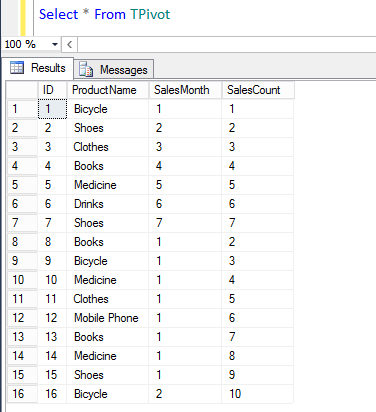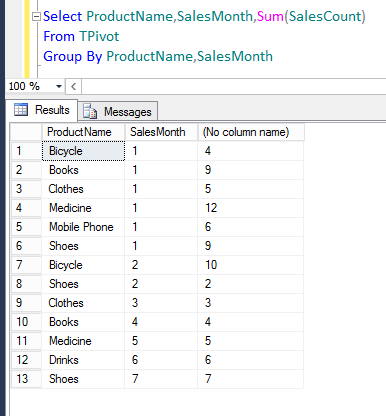测试数据
Create Table TPivot ( ID int identity(1,1), ProductName Varchar(20), SalesMonth int, SalesCount int ) insert into TPivot Values ('Bicycle',1,1), ('Shoes',2,2), ('Clothes',3,3), ('Books',4,4), ('Medicine',5,5), ('Drinks',6,6), ('Shoes',7,7), ('Books',1,2), ('Bicycle',1,3), ('Medicine',1,4), ('Clothes',1,5), ('Mobile Phone',1,6), ('Books',1,7), ('Medicine',1,8), ('Shoes',1,9), ('Bicycle',2,10)
数据


Pivot语法
/**** SELECT 非透视列, [透视列 1] AS '列名1', [透视列 2] AS '列名2', [透视列 3] AS '列名3' FROM ( -- 源数据 SELECT 非透视列, 透视列值的来源列, 需要聚合的值 FROM 表 )AS 别名 PIVOT ( SUM(需要聚合的值) FOR 透视列值的来源列 IN ([透视列 1],[透视列 2],[透视列 3]) )AS 别名 ****/
代码
Select ProductName, Isnull([1],0) As '1', Isnull([2],0) As '2', Isnull([3],0) As '3', Isnull([4],0) As '4', Isnull([5],0) As '5', Isnull([6],0) As '6' From ( Select ProductName,SalesMonth, SalesCount From TPivot ) As Sales Pivot ( Sum(SalesCount) For SalesMonth In ([1],[2],[3],[4],[5],[6]) ) As PivotBL
效果
